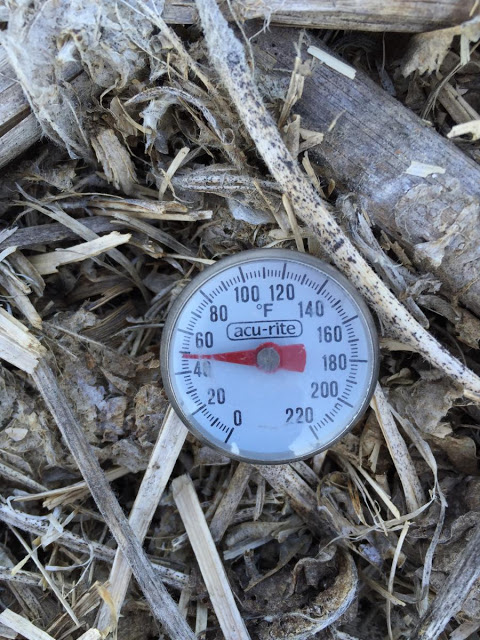October 17, 2018

Source: University of Minnesota
By Fabian Fernandez, Nutrient Management Specialist
Farmers are some of the hardest working people I know. Many highway drivers seeing fields harvested as they travel may think, “farmers are done for the year.” For farmers, the reality is that the work is just beginning for the next cropping season. Among the many decision that farmers need to make, nitrogen decisions are one of the major ones right now. The recent wet conditions, including snow, create certain level of anxiety to get things done before the winter. But before you get into too much of a hurry to apply nitrogen, here are a few things to give serious consideration.
When to apply
Soil temperature can greatly impact the efficiency of fall nitrogen applications. Although nitrifying bacteria are active until the soils freeze at 32°F, their activity is substantially reduced once soil temperature drop below 50°F. For this reason, you should direct fall nitrogen applications by soil temperature and not by date of year. This guideline applies equally for any acceptable nitrogen source for fall application, including when a nitrification inhibitor is used.
The efficacy of nitrification inhibitors decreases with warm temperatures because high temperatures cause faster breakdown of the inhibitor. The cooler the temperature, the greater the efficiency of the inhibitor, and the greater the chance that ammonium does not convert to nitrate.
In most years, the 50°F temperature allows enough time to get nitrogen applied before soils freeze. It makes no sense to increase the risk of nitrogen loss by starting applications too early. Remember that applying once the soil temperature is 50°F does not automatically ensure no nitrogen loss. The longer you can wait for temperatures to get lower than 50°F and still get your application done, the better.
Air temperatures can vary substantially during the early fall, which affects soil temperatures. Even if soil temperatures are approaching 50°F, there’s a strong chance that they’ll bounce back to warmer levels.
You can find up-to-date soil temperatures here. Use this as a guide. Soil temperatures at the 6-inch depth can vary substantially based on soil texture, color, moisture content and crop residue coverage. The best thing to do is to test the temperature in your specific field before applying nitrogen.
What form of nitrogen to apply
For fall, anhydrous ammonia is the best source because it remains in ammonium form longer than any other inorganic nitrogen source. A nitrification inhibitor with anhydrous ammonia can help extend the time nitrogen stays in ammonium form. The longer nitrogen is in the ammonium form the better because ammonium, unlike nitrate, will not leach or denitrify.
Historically, we have recommended urea as one of the sources for western Minnesota, where spring conditions are drier. Though lately we have been seeing wetter conditions in that area, which means more potential for nitrogen loss and lower yields compared to spring urea applications. Nitrification inhibitors have not shown consistent results with urea. Also, ongoing research with polymer-coated urea shows inconsistent benefits compared to the same application with urea in the fall, and lower yields compared to anhydrous ammonia.
Ammonium sulfate is an acceptable nitrogen form for regions where fall urea is acceptable. This source also provides sulfur, but like nitrate, sulfate will leach out. Applying this source in the fall will provide little sulfur benefit to the next crop. Further, ammonium sulfate is typically more expensive and has more acidifying potential to the soil than other nitrogen sources.
Where to apply
Don’t fall-apply nitrogen to soils with high potential for nitrate leaching in the fall or early spring. This includes sandy soils, shallow soils with gravely subsurface or those with excessive drainage, like the karst soils in southeastern Minnesota. Also avoid soils with very poorly drained conditions, especially where water tends to pond, as the potential for nitrogen loss is large.
How to apply
Soils that are too dry or too wet can result in ammonia loss to the atmosphere from anhydrous ammonia because the application knife tracks may not seal properly.
To determine the economically optimal nitrogen rate use this corn nitrogen rate calculator.
Please remember that these rates were calculated based on corn response to nitrogen applied in the spring. Although nitrogen does not have to be applied in the fall, some farmers might have logistical or other reasons to apply nitrogen in the fall. Unfortunately, because spring weather conditions greatly influence nitrogen loss, it is impossible to know in any given year how risky it is to apply nitrogen in the fall, even when you apply under ideal conditions to protect nitrogen. In general fall nitrogen applications result in lower yields than the same application done before planting in the spring. You don't have to apply the entire amount in the fall, if you don't like taking big risks. But if a fall application makes sense, it may be better to apply some nitrogen in the fall and the rest in spring.
Originally posted by the University of Minnesota Extension.
You May Also Like




